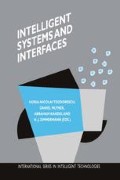Abstract
In this and the following chapter we discuss a neuro-fuzzy approach to natural language processing. We design a generic device based on a combined architecture of fuzzy logic representation with neural network learning and adaptation. The device uses natural language to interactively communicate with its human environment, it follows the“ conversation’ s” context and understands the meaning of each sentence, and then executes it. The device is capable of learning in real-time, based on environmental (user) feedback and past experience, and is capable of adjusting its internal perception of the world with every interaction with the environment that holds some change or innovation. In the following chapter, we introduce two novel fuzzy learning algorithms that the device uses to learn new abstract terms and to adjust existing ones in the course of performing its task. We present a real-world application to demonstrate the principles of the device.
Access this chapter
Tax calculation will be finalised at checkout
Purchases are for personal use only
Preview
Unable to display preview. Download preview PDF.
References
A. Kandel and G. Langholz (Editors), Hybrid Architectures for Intelligent Systems, CRC Press, 1992.
E. Ferri and G. Langholz,“Neuro-Fuzzy Application to Natural Language Understanding”, Proc. International Conference on Intelligent Technologies in Human-Related Sciences, Leon, Spain, 1996, Vol. 1, pp. 31–37.
A.L. Gorin, S.E. Levinson, L.G. Miller, A.N. Gertner, A. Ljolje, and E.R. Goldman,“On adaptive acquisition of language”, Proc. IEEE International Conf. on Acoustics, Speech and Signal Processing, 1990, Vol. 1, pp. 601–604.
A.L. Gorin, S.E. Levinson, A.N. Gertner, and E.R. Goldman,“Adaptive acquisition of language”, Computer Speech and Language, 1991, Vol. 5, pp. 101–132.
A.L. Gorin, S.E. Levinson, and A.N. Gertner,“Adaptive acquisition of spoken language”, Proc. IEEE International Conf on Acoustics, Speech and Signal Processing, 1991, Vol. 2, pp. 805–808.
L. Miller and A.L. Gorin,“A structured network architecture for adaptive language acquisition”, Proc. IEEE International Conf. on Acoustics, Speech and Signal Processing, 1992, Vol. 1, pp. 1201–1204.
A.L. Gorin, L.G. Miller, and S.E. Levinson,“Some experiments in spoken language acquisition”, Proc. IEEE International Conf on Acoustics, Speech and Signal Processing, 1993, Vol.1, pp. I-5O5-I-5O8.
K. Farrell, R.J. Mammone, and A.L. Gorin,“Adaptive language acquisition using incremental learning”, Proc. IEEE International Conf on Acoustics, Speech and Signal Processing, 1993, Vol. 1, pp. 1501–1504.
A. Sankar and A.L. Gorin,“Visual focus of attention in adaptive language acquisition”, Proc. IEEE International Conf on Acoustics, Speech and Signal Processing, 1993, Vol. 1, pp. 1621–1624.
A.L. Gorin, S.E. Levinson, and A. Sankar,“Experiment in spoken language acquisition”, IEEE Trans. on Speech and Audio Processing, 1994, Vol. 2, pp. 224–240.
W.H. Press, B.P. Flannery, S.A. Teukolsky, and W.T. Vetterling, Numerical Recipes in C: The Art of Scientific Computing, Cambridge University Press, 1991, pp. 94–98.
A.V. Oppenhiem and A.S. Willsky, Signals and Systems, Prentice-Hall, 1983, pp. 22–23.
E. Ferri, A. Kandel and G. Langholz,“Fuzzy Negation”, in Computing with Words in Spoken Analysis, L.A. Zadeh and J. Kacprzyk (eds.), Springer-Verlag, 1999.
F.G. Stremler, Introduction to Communication Systems (3rd Ed.), Addison-Wesley, 1990, pp. 386–390.
J.D. Foley and A. Van Dam, Fundamentals of Interactive Computer Graphics, Addison-Wesley, 1984, pp. 245–255.
Editor information
Editors and Affiliations
Rights and permissions
Copyright information
© 2000 Springer Science+Business Media Dordrecht
About this chapter
Cite this chapter
Ferri, E., Langholz, G. (2000). Neuro-Fuzzy Approach to Natural Language Understanding and Processing. In: Teodorescu, HN., Mlynek, D., Kandel, A., Zimmermann, HJ. (eds) Intelligent Systems and Interfaces. International Series in Intelligent Technologies, vol 15. Springer, Boston, MA. https://doi.org/10.1007/978-1-4615-4401-2_8
Download citation
DOI: https://doi.org/10.1007/978-1-4615-4401-2_8
Publisher Name: Springer, Boston, MA
Print ISBN: 978-1-4613-6980-6
Online ISBN: 978-1-4615-4401-2
eBook Packages: Springer Book Archive

